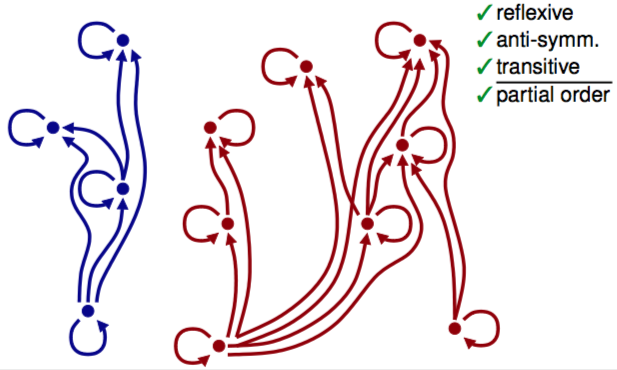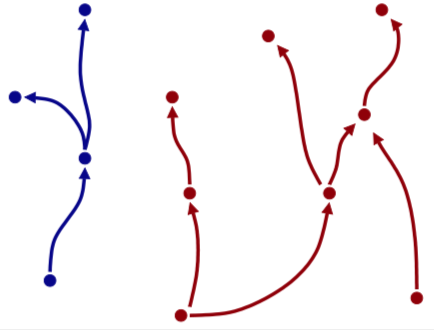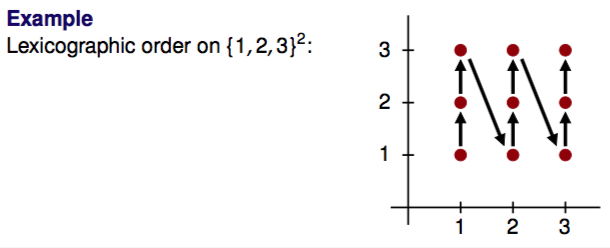Logic & Sets
Table of Contents
Partial orders
partial order on V: relation R of type V × V. satisfies reflexivity, anti-symmetry, transitivity
example: relation ≤ is partial order on N
- ∀n: n ≤ n (reflexivity)
- ∀m, n: m≤n ∧ n≤m ➝ m = n (anti-symmetry)
- ∀k, m, n: k≤m ∧ m≤n ➝ k≤n (transitivity)
example: the relation ⊆ is partial order on P(V)
- ∀A: A ⊆ A (reflexivity)
- ∀A,B: A ⊆ B ∧ A ➝ A = B (anti-symmetry)
- ∀A,B,C: A ⊆ B ∧ B ⊆ C ➝ A ⊆ C (transitivity)
linear ordering relations
partial order R on set V, then:
- x, y ∈ V are comparable if x R y or y R x
- R is linear/total order if all x,y ∈ V are comparable
e.g. relation ≤ on N: for all n,m in N — n ≤ m or m ≤ n — total
e.g. relation ⊆ on P({1,2}): {1} is not a subset of {2}, {2} is not a subset of {1} — not total
strict partial ordering relations
if partial order R on set V, then strict partial order S corresponding to R is defined by
x S y ⟷ x R y and x ≠ y
a strict partial order is irreflexive, anti-symmetric, transitive
Hasse diagrams
apparently a partial ordering relation is complicated as fuck:

so get rid of some arrows and make a Hasse diagram — omit reflexivity and transitivity
the arrows create chains that split and merge, elements in the same chain are comparable

Algorithm:
- For all x ∈ V — Gx := {y : y ≠ x and x R y}
- For all x ∈ V — Hx := Gx \ {z : z ∈ Gy for a y ∈ Gx}
- For all x ∈ V — draw and arrow from x to every y ∈ Hx
example:

Cartesian order on A × B
<a1, b1> ≤ <a2, b2> ⟷ a1 ≤A a2 and b1 ≤B b2
ordered by points, if both are smaller
cartesian order on A × B is a partial order

Lexicographic order on A × B
<a1, b1> ≤ <a2, b2> ⟷ (a1 <A a2) ∨ (a1 = a2 ∧ b1 ≤B b2)
like in a dictionary
lexicographic order on A× B is a partial order, total if ≤A on A and ≤B on B are total

Minimal and maximal elements
(V, ≤) is a partially ordered set, A ⊆ V, m ∈ A
m is:
- largest element of A — if ∀a ∈ A : a ≤ m
- smallest element of A — if ∀a ∈ A : m ≤ a
- maximal element of A — if ∀a ∈ A : (M ≤ a ➝ m = a) — no outgoing arrows on Hasse diagram
- minimal element of A — if ∀a ∈ A : (a ≤ m ➝ a = m) — no incoming arrows on Hasse diagram
Every maximum of A is a maximal element of A. If A has a maximum, it is the only maximal element.